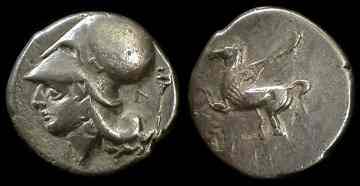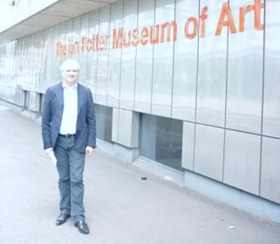The modern day emphasis on electronic banking and plastic credit cards could pave the way towards a future where people no longer carry around coins, Classics and Archaeology curator at the Ian Potter Museum of Art, Dr Andrew Jamieson says.
 A sombre thought considering how engrained coinage is in history, and how much one small token can represent.
A sombre thought considering how engrained coinage is in history, and how much one small token can represent.
Ancient coins: heads and tails from antique lands, the exhibition currently running at the University of Melbourne's Ian Potter museum is a rare opportunity to take a glimpse through history, Dr Jamieson says.
This exhibition, which will run until April next year, is the first time that some of these coins have gone on public display.
"The coins were acquired in two main stages of acquisition, in the 1920s and then in the 1970s and 1980s. There's been two coin exhibitions, one in the '70s and one in the '90s. These coins don't come out very often, it's worth coming to see them," he says.
Melbourne University has approximately 450 ancient Greek and Roman coins, a selection of which are in this exhibition, but there are also coins on display from several private Melbourne coin collectors.
"The thing that is remarkable about coins is that they've survived for several thousand years and undergone very little change," Dr Jamieson says, comparing an ancient Grecian coin featuring Athena on the front and a wreath of olives on the back to a modern-day Australian coin featuring Queen Elizabeth II on the head and Australian emblems (a kangaroo and an emu), on the tail.
"One of the most fascinating aspects of ancient coinage is that we can appreciate them for their fine aesthetic qualities and the production of these very small objects, but it's the information and iconography that is represented on the surfaces, whether it's mythological, political, historical, that is truly remarkable, and it hasn't really changed over time," he says. "I think that's one of the reasons why coins or an exhibition of coins is very popular; people are drawn to coins because of the qualities that are represented," he says.
Silver coins made in Attica, which are on display, are characterised by the depiction of Athena, often in profile, and on the reverse features the figure of the owl, a symbol of the city but also associated with the attributes of Athena, who was a goddess of war but also of wisdom.
The owl is a reference to that quality, Dr Jamieson says. Often the Attic coins will feature an olive wreath, as Athena's gift to Athens was olives, he adds.
The oldest coin in the exhibition is from 610 BC from Lydia, in western Turkey, and made of electrum.
"Coinage, even though it may originate in Lydia, was embraced by ancient Greeks and, it spread to the west Greek worlds, and Greek city states adopted this and started minting their own coins and, of course, you've got wonderful coinage produced in Attica," he says.
Melbourne Cardiologist and amateur numismatist, Dr John Voukelatos, who has been collecting coins for about 15 years, with a focus on Greek, Sicilian and Magna-Grecian (Southern Italian) coins, describes the exhibition as a must-see. "This collection is quite interesting; it's got a large spectrum of Greek inspired coins but it's a unique exhibition because it's not something that happens very often," Dr Voukelatos told Neos Kosmos.
 The coins in the exhibition are in magnificent condition, he says, explaining that collectors look for clarity of image, centring, no dints, and for every dot around the edge of the coin to be present.
The coins in the exhibition are in magnificent condition, he says, explaining that collectors look for clarity of image, centring, no dints, and for every dot around the edge of the coin to be present.
Many of the coins on display are also very rare, he adds, quick to define 'rarity' in numismatics. "What determines rarity is whether it's hard to find, whether it's in good condition and whether it has any sort of history, if it's been published or in circulation for a period of time," he said.
The old coins on display, mainly from Peloponnese, have all been acquired from a famous Greek collector, who spent 40 years of his life building up a 35,000 coin collection: one of the largest collections of Greek coins and coins in general.
Dr Voukelatos has met this man, who still lives in Athens and goes only by the initials BCD, and says some of the coins on display are some of BCD's best examples.
Ancient Greek history is represented vividly through the coins displayed. Dr Voukelatos points out the "coin of necessity", a silver plated bronze coin, minted in Athens in about 410 BC, and made from a copper bronze core to compromise a silver shortage at the time.
The silver shortage was due to the Peloponnesian Wars when Athenians couldn't access their silver mines outside Athens because the Spartans had laid siege to the city.
Authenticating coins in ancient times was another difficulty as counterfeits were always a concern, Dr Jamieson says, pointing to a coin with a cut across the face.
"Historically this is what is known as a banker's test cut, and that was to check the quality of the metal because even in antiquity they were counterfeiting ancient coinage by dipping bronze coins in silver and passing them off as solid silver," he said. Another trick was to clip the edges of coins and use those clippings to produce more coins.
This may even be one of the original reasons the coin has two faces, to make it harder to counterfeit, Dr Jamieson suggests. He says coinage really evolved with technology and the changing purposes of the coin.
"With all coins there are two sides, the obverse and the reverse or the head and the tail. We know in the production of coins it was often the top that is stamped first and that it's the reverse that's impressed at the base of the flan in the production. We know coins were made with discs of metal that were softened through heating before being impressed or struck to produce the coins and obviously they perfected coins over hundreds of years and historically they go from a fairly thick, sort of solid slightly irregular shaped piece to becoming far more regular and thinner like the Byzantine coins and some Islamic coins of a later period," he said.
The changing shapes and weight of the coins were most likely technological developments and possibly also to do with value and standardization of the coin.
"The oldest coins in this exhibition were probably not used like the small change we carry around to buy a loaf of bread or milk, they were often used to pay soldiers or mercenaries and it was a way of transporting wealth in a manageable scale; these coins during their lifetime were probably very valuable," Dr Jamieson says.
The exhibition is an opportunity for the Greek community, and other communities, to catch a glimpse of history, even if it's just for a moment in time, Dr Voukelatos says.
"As a collector you never really own coins, at best you end up being part of this long line of people who have owned these interesting coins," he says. Some of the coins in the exhibition were once owned by British Archaeologist Sir Arthur Evans, who was famous for unearthing the palace of Knossos in Crete, the Metropolitan Museum of Art (MET) in New York, and English art historian and writer Charles Seltman.
The exhibition will run until April 10, 2011, at the Ian Potter Museum of Art, Melbourne University, Swanston St (between Elgin and Faraday Sts). Admission is free. For more information visit: www.art-museum.unimelb.edu.au
Author: Laura Burgoine | Source: Neos Kosmos [December 05, 2010]